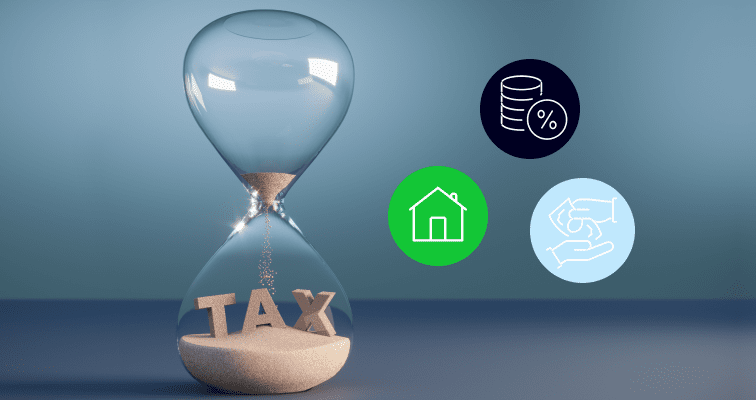When you sell financial assets, you may need to pay capital gains tax (CGT). Find out what it is, how it works in Germany, and what you need to know to navigate it as an investor.
The process of investing can be relatively straightforward. User-friendly trading platforms provide a trusted way to deposit funds, choose assets to invest in, and buy them. However, after you have sold some or all of your shares, you may have to pay capital gains tax on any profits you make.
This guide can help you to navigate the process seamlessly and cost-effectively. It explains what German CGT is, how to calculate it, and how you can make sure that you pay no more than the legal requirement.
What is capital gains tax (CGT)?

In Germany, if you buy assets from capital markets and make an income from them, or sell them for a higher price than that at which you bought them, you must pay capital gains tax (“Kapitalertragsteuer” or “KESt”) on any profits. The process in Germany is overseen by the Federal Central Tax Office.
In some other countries, a “capital gain” relates solely to the difference between the value at which you bought and sold an asset. In Germany, CGT is slightly more complex, as taxable income includes items such as dividends or interest received from an asset.
Tip: Capital gains tax in Germany can be viewed as an income tax on capital income.
The amount of CGT you pay will depend on numerous factors, including the nature of the assets, your marginal tax rate, and where you live. Some regions of Germany will levy a Church tax (“Kirchensteuer“) on residents’ CGT obligations, and it is also important to consider the solidarity surcharge. The duration for which you have held an asset also impacts CGT, as it is applied at a more favourable rate in the case of long-term investments (investments held for over a year).
A capital loss refers to an investment where you sold an asset for a price lower than what you paid for it. While there is no CGT liability on capital losses, they still need to be considered, as capital losses can be offset against other capital gains.
What assets have capital gains tax?
The scope of CGT for investors in Germany extends beyond just potential profits made from trading stocks and shares to encompass interest income, dividends, capital gains and capital appreciation.
While the following list is not exhaustive, capital gains tax is generally applicable to profits from the sale of:
- CFDs and other derivatives
- Securities
- Intangible assets
- Dividends
- Interest from banks and fixed-interest securities
- Distributions from investment companies
- Profit distributions from silent partnerships
- Certain life insurance contracts
- Gains from forward transactions
- Accrued interest on the sale of fixed-income securities
- Foreign investments
Certain investments fall outside the scope of CGT, including:
- Some assets, such as income from private and business loans
- Interest from mortgages and land charges
- Income from overseas accumulating funds
- Income from endowment life insurance policies concluded before January 1, 2005, with a policy term of at least 12 years, may have lower or no CGT.
Typically, agents and financial institutions such as banks and investment firms will withhold any CGT due on your account, and pay it directly to the tax office on your behalf.
Despite this, it is your obligation as an investor to understand the overall tax landscape in Germany. In some circumstances, you may need to update the tax office regarding your personal situation to ensure that the rate charged is correct. There is a lot of free information available online for such circumstances, detailing how to contact the tax authorities and how to file a tax return.
Seeking advice from a specialised tax agent, especially for substantial investment portfolios, can help to ensure accurate reporting of CGT liabilities and to explore potential avenues for reducing tax obligations.
How does CGT impact my other investments?
The most common CGT event occurs when an investor sells their shares, whether for a profit or a loss.
The German CGT system requires that CGT-payments be made for investors by the firm that manages their account. This payment is typically made at the time of the trade, with the intermediary firm in question calculating any CGT liability, and paying the tax office directly.
So, the most direct impact on your investments as an investor in Germany, is that you will receive less overall investment income than you would if CGT didn’t apply.
How do I calculate my CGT?
Up to three separate tariffs go into formulating your CGT liability:
- The first is the national rate of CGT — 25% — which will apply to most people.
- The second is a solidarity charge (a surcharge levied on capital investment income in Germany, introduced to meet the costs of German unification) which is 5.5% of the CGT rate (1.38%). This increases the basic effective CGT rate in Germany to 26.375%.
- Finally, if you live in a region where Church tax applies, then the ultimate CGT rate will be further increased.
If you want to calculate your CGT obligations yourself, there are three key stages to work through:
- Calculate your capital gain. To do so, work out the difference between the purchase and sale price of the asset plus any commissions or fees you paid. Do not forget to include income such as reinvested dividends.
- Confirm your CGT rate, taking into account the national rate and applying the solidarity surcharge or church tax if applicable.
- Establish how long you have held the assets. The standard rate of 25% only applies if your investment was held for more than one year (for movable assets) or 10 years (for real property). If you held the position for a shorter period of time, your individual progressive rate of tax will be applied.
To make things clearer, consider some examples. Taking the given rates of CGT, solidarity charge and variable Church tax rates, your effective CGT rate will likely be one of the below:
| No Church tax | 25% capital gains tax + 1.38% solidarity surcharge | CGT rate = 26.38% (solidarity surcharge only) |
| Church tax of 8% | 25% capital gains tax + 1.38% solidarity surcharge + 8% Church tax | CGT rate = 28.38% (solidarity surcharge + 8% Church tax) |
| Church tax of 9% | 25% capital gains tax + 1.38% solidarity surcharge + 9% Church tax | CGT rate = 28.63% (solidarity surcharge + 9% Church tax) |
Before questioning the value of your investment efforts, consider the savers’ lump-sum allowance (“Sparerpauschbetrag”). This allowance, which is available to all German tax residents, allows a certain amount of investment gains before CGT is applicable. In each tax year, individuals can receive €801 in profits on capital investments before CGT is applied. For married couples, the allowance is €1,602 annually.
Should your personal circumstances mean that you are able to claim tax relief, or if you have underpaid your CGT, it is your responsibility to rectify the situation in your income tax return. To prevent CGT withholding at source, file an exemption order (“Freistellungsauftrag”) with your asset-holding institution. If you have multiple accounts with different agents, allocate your tax allowance accordingly.
Tip: If you forget to advise your financial agent of any exemptions that apply, you can complete a tax return to apply to claim back overpayments of CGT.
How can I minimise my CGT burden?

While you may not be able to avoid paying capital gains tax entirely, there are some situations where you can minimise the amount of tax you pay each financial year:
Holding for at least 12 months
Look to invest in long-term investments rather than short-term trades. If you hold movable assets such as stocks for at least 12 months, or property for 10 years, the tax rate applied on any profits will be the standard flat rate of CGT (25%), rather than the potentially higher individual progressive rate.
Take advantage of capital losses
Not all trades are winners, but the good news is that you can use capital losses to offset your capital gains, as long as both investment events occurred in the same tax year.
Monitor your tax situation
CGT is paid (at a default rate) by the agent or intermediary who holds your assets. The responsibility falls on individual investors to establish if the rate applied is correct, or to claim back any funds by completing a personal tax return.
Speak to a professional
A tax agent who specialises in investment taxation will be able to establish any ways that you can reduce your CGT. They can consider your individual circumstances, and will be able to steer you towards sensible strategies to minimise your tax burden, while helping you to avoid the risk of taking an overly aggressive approach, which might violate the tax code.
Final thoughts

Capital gains tax is an integral part of the investment process. It is crucial that investors in Germany familiarise themselves with the way in which German CGT works, to comply with tax regulations and understand the options available to them to minimise their tax burden.
Ensure that you conduct research, and if necessary, consult with a tax professional for expert advice. Keep records of every CGT asset you acquire, and most importantly, enjoy your investment journey!
Join eToro today and learn more about CGT, investing in shares and trading in general.
FAQs
- I’m not religious, are there ways that I can avoid paying the Church tax?
-
German Church Tax applies to any German tax resident who has been baptised in the Catholic or Protestant faiths or belongs to the Jewish faith. If you make an official renunciation of your faith, you are no longer subject to Church tax. However, you would have to advise the financial institution and tax office of this change, as otherwise the Church tax will still be withheld at source.
- How can I get a breakdown of how much CGT was charged on my holdings?
-
Most financial agents who hold your assets will issue a statement explaining the details of each instance that CGT is applied. It will include the gross value of a cash distribution and the tax withheld. They are also likely to issue an annual statement, which will give a full breakdown of the previous tax year
- How can I make the most of my Sparerpauschbetrag (savers’ lump-sum allowance)?
-
Your CGT tax-free allowance of €801 applies to each tax year and operates on a “use it or lose it” basis. If you have unrealised net profits that are greater than the €801 threshold, then staggering the closing out of the position so that it occurs over two tax years would allow you to use two different years’ worth of allowances and reduce your total tax liability.
This information is for educational purposes only and should not be taken as investment advice, personal recommendation, or an offer of, or solicitation to, buy or sell any financial instruments.
This material has been prepared without regard to any particular investment objectives or financial situation and has not been prepared in accordance with the legal and regulatory requirements to promote independent research. Not all of the financial instruments and services referred to are offered by eToro and any references to past performance of a financial instrument, index, or a packaged investment product are not, and should not be taken as, a reliable indicator of future results.
eToro makes no representation and assumes no liability as to the accuracy or completeness of the content of this guide. Make sure you understand the risks involved in trading before committing any capital. Never risk more than you are prepared to lose.


